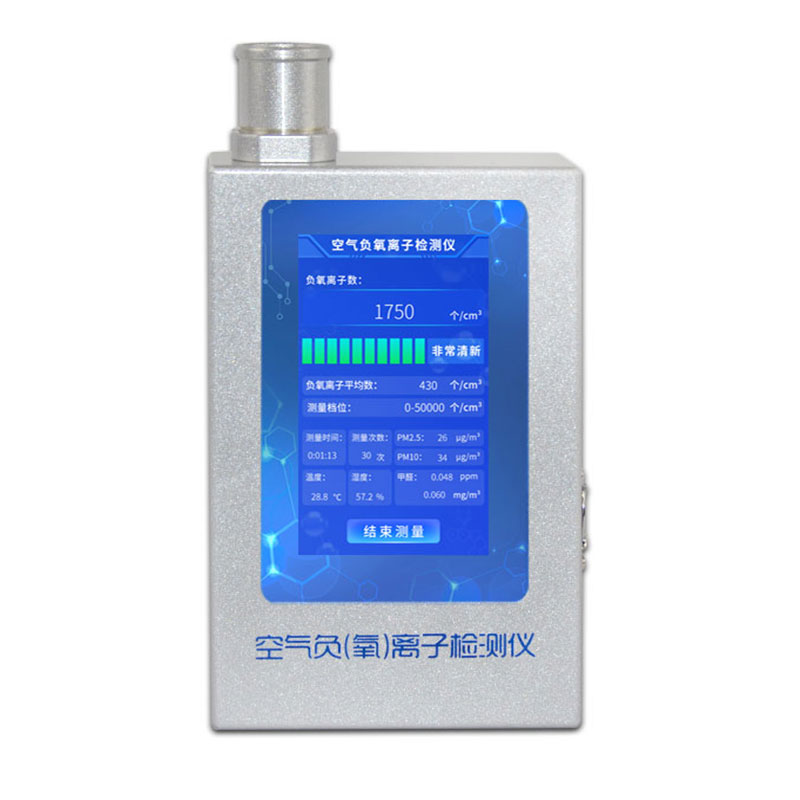Shandong Fengtu IOT Technology Co., Ltd
Sales Manager:Ms. Emily Wang
Cel,Whatsapp,Wechat:+86 15898932201
Email:info@fengtutec.com
Add:No. 155 Optoelectronic Industry Accelerator, Gaoxin District, Weifang, Shandong, China

Sales Manager:Ms. Emily Wang
Cel,Whatsapp,Wechat:+86 15898932201
Email:info@fengtutec.com
Add:No. 155 Optoelectronic Industry Accelerator, Gaoxin District, Weifang, Shandong, China

Model:FT-FY4
Brand:fengtu
Negative oxygen ion monitor
Negative oxygen ion monitor can collect specific negative oxygen ions in the air and calculate its concentration value, and monitor the change of atmospheric negative ion concentration all weather.
Features: Mobile measurement | Start measuring | Intuitive reading | Simple operation | Ultra-long standby time
Negative oxygen ion monitor product introduction:
Negative oxygen ion monitor is a high-precision, professional instrument for detecting and analyzing negative air ions, formaldehyde, PM2.5, PM10, and air temperature and humidity. It uses an advanced cylindrical capacitor structure negative (oxygen) ion capture mechanism to capture negative (oxygen) ions in the atmosphere, and then uses a unique algorithm to perform precise statistical calculations. It has the advantages of stable measurement process, rapid response, and accurate measurement results. At the same time, it has strong resistance to electromagnetic, static electricity, and electromagnetic wave interference, and has excellent sensitivity and capture ability for small-particle negative ions, with superior overall performance.
Negative oxygen ion monitor is easy to operate, with a 5.0-inch full-color large screen that displays real-time measurement data, instrument working status, and automatically calculates average values. Operators can quickly measure without professional training.
Negative oxygen ion monitor product applications:
It can measure the atmospheric negative oxygen ion concentration, formaldehyde concentration, PM2.5, PM10, temperature and humidity in the air in real time. It is the preferred tool for measuring and demonstrating the negative ion concentration of environmental testing, nano-coatings, negative ion health products, negative ion home improvement building materials, indoor testing, air treatment, air purifiers and their products.
Negative oxygen ion monitor working principle:
The principle of "capacitive inhalation method" is used to detect negative ions and measure the concentration of negative ions in the air. A certain amount of polarization voltage is loaded on the polarization plate (or bias plate) of the ion sensor (or collection barrel, collection tube), and the air to be measured passes through the sensor at a set speed. Specific small-particle negative ions in the air are deflected under the action of the electric field and captured by the collection plate. The negative charge of the collected negative ions is processed by the collector to calculate the charge concentration of the negative ions.
Negative oxygen ion monitor advantages and features:
1. Screen display: 5.0-inch capacitive touch screen, 800*480 high resolution, real-time display of multi-parameter measurement results;
2. Accurate measurement: using the internationally advanced cylindrical capacitive suction method as the measurement method;
3. Small size: compact internal structure, exquisite appearance, can adapt to various environmental detection, convenient for mobile use;
4. Ultra-long standby time: built-in large-capacity lithium battery (12V 3000mAh), not limited by power supply and site, and can be tested immediately after turning on;
5. Sensitive response: data refresh frequency reaches 1 second/time;
6. Simple operation: The instrument is easy to operate and the full-color large font display is clear and concise;
Negative oxygen ion monitor technical parameters:
Negative ion concentration:
Measurement function: manual measurement, automatic measurement;
Measurement method: Cylindrical capacitor structure negative (oxygen) ion capture mechanism;
Measuring range: 0-50,000, 1000-500,000, 1000-500,000;
Measurement accuracy: ±5%
Resolution: 1 piece/cm3
Mobility: 0.4~1.0 (cm2/V*sec)
Measurement interval: 1 second/time
Measuring mode: continuous
Communication interface: USB
Working environment: Temperature: 0~60℃; Humidity: 0~85%RH
Power supply: DC12V 1A adapter
Built-in battery: battery power supply time ≥ 8 hours
Average power consumption: ≤2W
Dimensions: 200mm*132mm*58mm
Body weight: 1kg
Shell material: metal
Formaldehyde parameters:
Display data unit: ppm and mg/m³;
Range: 0-5ppm;
Resolution: 0.01ppm;
Warm-up time: less than 3 minutes;
Response time: less than 60 seconds;
Recovery time: less than 60 seconds;
Working temperature: -20℃~50℃;
Working humidity: 15%RH~90%RH (no condensation);
Storage temperature: 0℃~25℃;
Service life: 5 years (18℃-25℃ in air)
PM2.5/pm10 parameters:
Display data: PM2.5 and PM10;
Measuring range: 0.3~10μm;
Effective range of particle mass concentration: 700μg/m³;
Maximum range of particle concentration: greater than 1000μg/m³;
Particle mass concentration resolution: 1μg/m³;
Response time: 1~10 seconds;
Working temperature: -10℃~60℃;
Storage temperature: -30℃~80℃;
Working humidity (non-condensing): 5%RH~80%RH;
Storage humidity (non-condensing): 0%RH~95%RH;
Particle mass concentration consistency (0~100μg/m³): ±10μg/m³;
Particle mass concentration consistency (≥100μg/m³): ±10%μg/m³;
Temperature and humidity parameters:
Temperature range: -40℃~+125℃; accuracy: ±0.3℃
Humidity range: 0%HR-100%HR; accuracy: ±3%HR
Mounting bracket: tripod (optional)
Accessories: adapter, cleaning brush, USB data cable, special protective suitcase
Soil moisture monitoring is crucial for agricultural production, water resource management, flood warning and drought assessment. Soil moisture research has been carried out at home and abroad.For example, in the mid-to-high altitude areas of Switzerland, the SOMOMOUNT network has been established t...
The mini weather station is an integrated structure and highly integrated weather sensor, which can provide a variety of elements to be monitored in combination, measuring PM2.5, PM10, CO, SO2, NO2, O3, temperature, humidity, wind speed, wind direction, atmospheric pressure, rainfall and other eleme...
As the air quality problem becomes increasingly serious, real-time monitoring of air quality is particularly important. By building micro-monitoring stations, we can achieve real-time monitoring of air quality and timely detection of sources of pollution in the atmosphere. The application of this te...
Soil moisture monitoring techniques fall into three main categories: direct measurements, matrix potential measurements and non-contact indirect measurements.Direct measurements: moisture content is calculated by weighing and drying soil samples, or measured directly using instruments such as neutro...